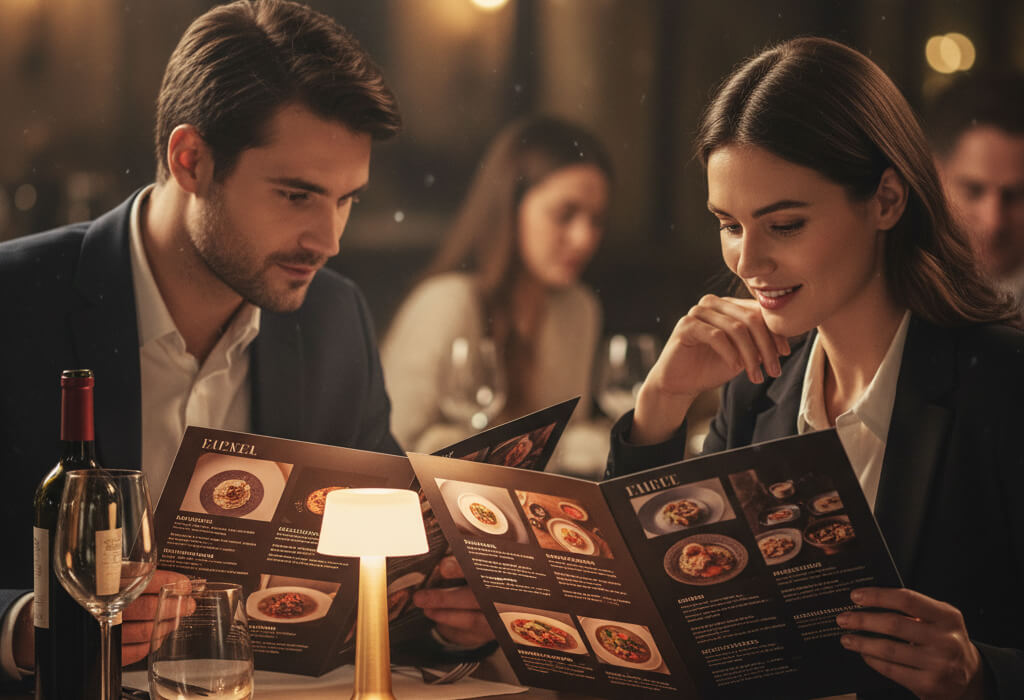October 06, 2025

Menus aren’t just about listing what’s in the kitchen. They are carefully crafted tools that tap into psychology, influence spending, and silently guide guests toward choices that benefit both the diner and the business. From how items are placed to how they’re described, your menu can be one of your most effective marketing and revenue-generating assets—especially when it’s optimized for both print and digital.
Let’s break down how strategic menu design works—and how you can apply these principles in both your restaurant and your website.
The structure of your menu matters as much as its content. Research shows that diners scan menus in predictable patterns. The “Golden Triangle” theory suggests people look first at the center, then move to the top right, and finally to the top left. These areas are prime real estate—ideal for placing high-margin items, chef specials, or bestsellers.
In digital spaces, especially mobile devices, this scanning pattern still applies. A mobile-first restaurant website ensures that these menu zones are preserved on small screens. With more than 60% of diners checking menus on their phones before booking or arriving, how you display your offerings online is just as important as how they look in print.
You can also use visual hierarchy through:
These subtle cues draw the eye—and with it, the wallet.
How a dish is described has a profound impact on how it’s perceived. Simply calling something “Grilled Salmon” might not stir much excitement—but “Wild-Caught Atlantic Salmon with Smoked Sea Salt Glaze” sounds like a delicacy. According to Cornell Hospitality Quarterly, dishes with vivid descriptions are ordered 27% more often and justify higher price points.
This technique works beautifully for both dine-in menus and online ordering platforms. It’s especially powerful when backed by customer insights. Using data-driven tools to analyze what your customers respond to allows you to fine-tune your descriptions to match what your guests actually want.
Best practices:
Words can elevate a dish from forgettable to crave-worthy—especially online, where customers can’t smell or see the food beforehand.
Your menu doesn’t just affect in-house sales—it affects discoverability. Many restaurants overlook the SEO potential of their menu content. Google and other search engines crawl menu pages to match restaurants with search terms like “best spicy noodles near me” or “vegan brunch downtown.”
This means a well-formatted, keyword-rich online menu can drastically improve your visibility. As explained in RocketPages’ guide on optimizing your website for ‘near me’ searches, this small change can dramatically increase local traffic—especially from hungry people actively looking to spend money.
Here’s how to improve menu SEO:
A search-optimized menu helps diners find you, fast—and increases the chance they’ll actually visit.
Exclusivity and urgency are powerful motivators. Limited-time menu items—like a fall truffle pasta or a chef’s monthly tasting menu—can create buzz, encourage social media sharing, and drive return visits. Better yet, some restaurants are now experimenting with subscription-based dining models.
According to RocketPages, more restaurants are going subscription-based to generate predictable revenue and build stronger customer loyalty. These models work particularly well for:
These types of menus aren’t just functional—they create a sense of community and give customers a reason to keep coming back.
Smart menu design can subtly increase ticket size. For example:
In digital menus, these techniques can be dynamic. For example, if a guest selects a burger online, the platform could automatically suggest fries and a drink as a combo offer. These upsell cues can be personalized and powered by behavior-based logic—creating a more intuitive experience.
By connecting your menu layout to customer behavior data, you can tailor suggestions in real time—just like e-commerce platforms do.
Too many restaurants lose customer trust before diners ever set foot in the door—just because their menu is hard to read or navigate online. As RocketPages explains in their blog on common restaurant website mistakes, things like broken links, unreadable menus, and slow-loading pages can cost you real business.
Your menu should:
In today’s restaurant world, your menu is both your storefront and your salesperson.
A great menu doesn’t just inform — it influences.
Whether printed on leather-bound covers or accessed through a smartphone screen, the way you design and write your menu can guide diner behavior, increase sales, and strengthen brand identity. Combined with a modern, mobile-friendly website, smart use of data, and search engine optimization, your menu becomes a growth engine — not just a list of what’s for dinner.
Stay up to date with the latest tips, expert insights, product reviews, and step-by-step guides to help you grow, create, and succeed—no matter your industry or passion.